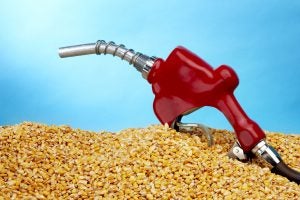In the film Elf (a modern day classic with the comedy stylings of Will Ferrell), Santa’s sleigh is powered by unwavering Christmas spirit. In the real world, modern life uses gobs of energy from a familiar landmark: the gas/diesel pump.
That’s oversimplifying of course. There’s plenty of other options like oil and coal. But it’s our unabashed love affair with the pump — and the quintessential lifeblood that it dispenses — that energizes the day-to-day farm life.
It may also translate to the dreaded Christmas sojourn for dinner with the in-laws(?), but purge that from your thoughts. Instead, consider what a marvel our ag infrastructure is. You might focus on sustainability metrics, like locally sourced goods and food miles.
Getting millions of dinners mobilized from farm to fork is no small feat. I tend to focus on how much energy it actually took to produce a plant or animal (and how much energy is recouped, post gorging). But it’s not as straightforward as calculating inputs like feed, fertilizer, and water into a spreadsheet. What about the vast infrastructure that spans the nation: the roads/interstate, rail system, and air freight? Not only that, but the one-time energy costs to extract a resource like metal ore from the Earth’s crust, to smelt it, and then fashion into a working cog in a larger transportation system. It’s an astonishing flow of seemingly boundless energy.
But our slow drawdown of oil has costs, guaranteed to get more complicated with “peak oil.” We’ve been able to stretch out what we have — using methods like fracking and better surveying of oil reserves — but it’s only prolonging the inevitable. Bottom line, demand is booming. The one-time bounty of oil entombed underground will eventually run out.
What we need is a technology that allows us to leverage existing infrastructure, with no monumental changes. That means the preservation of the old faithful gas pump.

Are biofuels like ethanol a tactical “tweener”? A solution that will bridge the transition from a dirty dalliance with fossil fuels to a clean, green economy?
Global problems necessitate global perspectives. Appropriately, I had the pleasure of hosting Dr. Tamás Mizik, a Fulbright Scholar from Hungary last week. As an economist, he gave his views on the biofuel question, especially corn-based ethanol. The following are my take-homes, as well as some of the discussion that followed. Disclaimer: These views are entirely my own, and in no way necessarily represent the view of Dr. Mizik.
As with any potential fuel, the main questions hover around carbon footprint and energy balance.
First, consider how biofuels glean their energy. The plant in the field photosynthesizes (by sucking up carbon and harvesting light energy) to build sugar (an on-demand form of energy). The plant then taps this energy, along with nutrients, to build biomass (put on weight). This biomass is then harvested and converted through an industrial process into ethanol. This recovers the energy initially invested by the farmer, plus a surplus (originally from the harvested light, now locked away in chemical bond form). Net positive energy balance.
But only barely.
One fuel measure is the energy returned on energy invested (EROEI). Basically, if one unit of energy is invested in corn, you can expect to get 1.3 units of energy back. Conversely, sugarcane is reported to have an EROEI of 8, much more energy dense (but with its own slate of problems, especially induced deforestation in the Amazon). Ethanol also has a lower energy density than gas. Gallon for gallon, ethanol can’t do the same amount of work. In an interesting plot twist, if we dedicated all US land currently in corn to ethanol, it would only satisfy only 12 percent of gasoline demand.
The other question is carbon balance. Corn ethanol does appear to have lower greenhouse gas emissions than gasoline. It’s also the oxygenate of choice — it’s blended with gas so the end product (called gasohol) burns cleaner, improving air quality.
Despite this, ethanol evokes a laundry list of risks, including land conflicts between food and fuel (duke it out in a gladiator match), fouled aquifers due to fertilizer use (corn is high maintenance), and water depletion. There’s also the potential for unanticipated consequences. If corn prices are high, farmers might be enticed to take land in conservation and bring it back into production, defeating the purpose of those set-asides in the first place.
Ethanol is also notoriously tough on engines, hence the cap at E10 (soon to be an E15 blend). Unless you have the rare flex fuel vehicle, you won’t be using E100 anytime soon.
In agriculture, we focus on the three F’s — food, fiber, and fuel — seemingly in that order. Without them, the witty saying is that we’d be hungry, naked, and stranded. While I’m not content being hungry or naked, I’d gladly ground ethanol for a re-evaluation. I appreciate why corn was the intuitive choice for this experiment in energy independence, as it had a tailor-made infrastructure that could be rapidly adapted.
Ignite the debate! Though some other implementations are promising (cellulosic and algae-based), corn ethanol belongs on the naughty list — with a lump of coal in its stocking. Far from being a fashionable whipping boy, I have genuine concerns about its viability on multiple fronts. In particular, the generous financial incentives (credits and subsidies, etc.) rightfully evoke cries of corporate pork, and bring unflattering attention to our industry. As a whole, the ethanol mandate is quite possibly the policy folly of the past 15 years. It’s a ghost of Christmas past that sorely needs to be retired.
Tim Durham’s family operates Deer Run Farm — a truck (vegetable) farm on Long Island, New York. As a columnist and agvocate, he counters heated rhetoric with sensible facts. Tim has a degree in plant medicine and is an Associate Professor at Ferrum College in Virginia.



